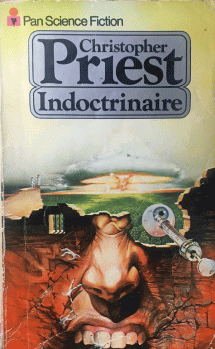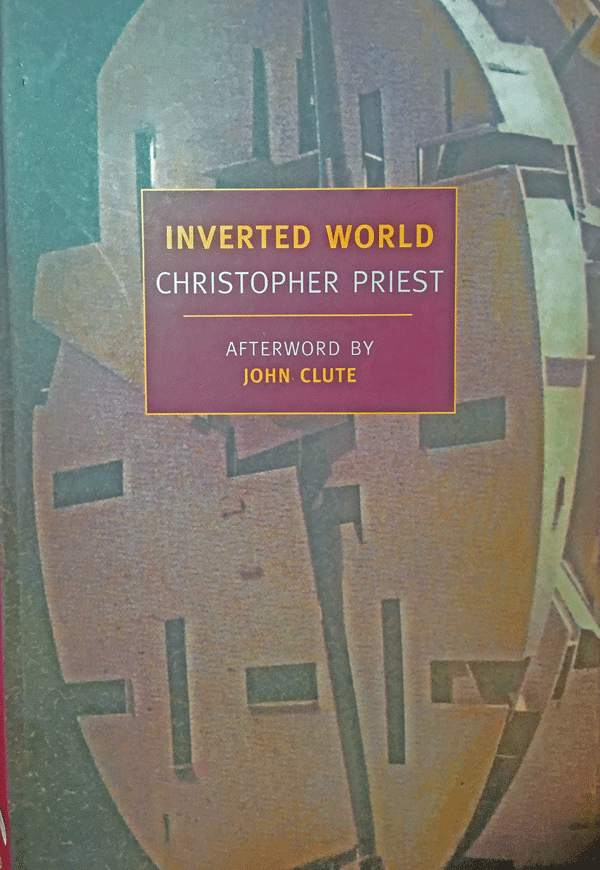Christopher Priest – “Indoctrinaire” and “Inverted World”

Indoctrinaire
Many years ago I was given the Pan Science Fiction copy of Christopher Priest’s novel Indoctrinaire (1971). The ghastly cover, hinting at lurid prose in aid of a ridiculously stupid plot ensured that I would not read the book, although it moved interstate and from house to house with me – for decades. Then recently I came across Andrew McKie’s revie in The Spectator of Priest’s 2016 novel, The Gradual (“a resounding success”). He says that Priest’s prose is “apparently prosaic – provided, that is, one means unshowy straightforward and devoid of ostentation. For the cumulative effect of his plain sentences, quotidian events and ordinary settings is decidedly, poetic, haunting and dreamy.” So I opened my copy of Indoctrinaire and what should fall out but a forgotten copy of that same review?
In his amusing “author’s note” to the revised edition, Priest says he can no longer recall why he called the book Indoctrinaire and we can be fairly sure that he did not approve the cover of the Pan publication. (No eyeballs are pierced by syringes in the book.)
The story opens promisingly enough, on a freezing plateau blasted by ice-laden gales. “Six hundred feet below the surface, on the rocks of the plateau itself – rocks which had not felt the warm touch of the sun in millions of years, if ever at all – man had dared to build. Well lit, well ventilated and centrally heated, the Advanced Technique Concentration carried on its functions in perfect security and with absolute impregnability”. Hundreds of (male) scientists work on their specialist subjects in the Concentration. “For the Concentration was no tiny station claiming a few square yards of Antarctic rock, but a complex system of research units linked by many tunnels through the ice. Its total area was thirty square miles, and it had been ten years in construction.”
Deep in one of the laboratories, British Dr Elias Wentik is working on – wait for it – mind-altering chemicals, tested on rats. Despite this rather disappointing trope, the setting is interesting enough for us (and Dr Wentik) to be annoyed when his neo-Pavlovian experimentation is interrupted by mysterious American government agents, who show Wentik an interesting photograph and then whip him off to a surreal jail in the Planalto District in Brazil, an isolated area in the jungle subject to a temporal irregularity. Wentik is held as a prisoner, subjected to interrogation and witness to strange and apparently irrational behaviours. Like K, he is accused of a crime he cannot identify. Unlike K he is pointed-at by a hand growing from a table. “It was built with perfection, like a Greek carving in skin and flesh. It was the normal size of a man’s hand, pale in the sunlight, but not bloodless. Tiny blond hairs grew on its back, refracting the sunlight. About three inches of wrist were visible before the arm disappeared into the tabletop fusing into the grainy, dark-stained wood. Incredibly, the hand started to drum its fingers, like those of a man kept waiting for an appointment”. [Vide Beast With Five Fingers, with Peter Lorre – ed.]
There is also a huge human ear growing from a wall, torture, incomprehensible machines, traps and tricks, and an insane military slant to the whole shebang. Wentik is drugged and taken from the compound to a hospital in Sao Paolo where he has sex with a nurse for no apparent reason other than to get some sex into the book. Finally he learns about the future he has himself created. As the author says in his note, this is “a reasonably conventional conclusion” and will not surprise any reader of science fiction over the age of 15 years; the novel is dated and there is no logical explanation for Wentik’s treatment at the jail or for many of the weird phenomena he experiences. However, it is a book worthy of a patient reader, perhaps a younger, less worldly and impatient one.
Inverted World
Inspired by Andrew McKie to give Priest a second chance, I picked up a nyrb copy of Inverted World (1974) a few weeks ago (It has a much nicer cover), and a less attractive Titan Books copy of Priest’s Islanders. (The Gradual is set in the Dream Archipelago of The Islanders.) Priest is harder to find in Australia than in the US, so I grabbed these; Inverted World at Bridge Street Books, Georgetown, Washington D.C. and Islanders at the famous Strand, New York…
The premise of Inverted World is lovely. The city called Earth is hauled across the landscape on rails which are labouriously built in front of and pulled-up from behind it. Children grow up in the city’s crèche. Helward Mann (“six hundred and fifty miles old”) has chosen the guild of his father, the Future Surveyors (other guilds are Bridge-Builders, Tracksmen and Militia). After a period of training, Apprentice Mann will travel in front of the city, preparing topological maps for use in planning its path. Earth must keep moving, in search of the mysterious “optimum“, which Apprentice Mann strives to understand –
“‘And the optimum is always moving?’
‘No. The optimum is stationary…but the ground moves away from it.’
‘Oh yes’.”
A marriage is arranged between Helward and a young woman he grew up with. Victoria will not be joining a guild. “She said that as a woman she was not automatically granted a responsible position, and only her engagement to me had made her present work possible. Had she become engaged to a non-guildsman, she would have been expected to produce children as often as possible, and spend her time on routine chores or whatever other manila tasks came along. Instead, she was now able to have some control over her future, and could probably rise to the position of a senior administrator.”
Apprentice Mann leaves the city for the first time and experiences a sunrise. He is gradually introduced to the surprising outside world, the lore of the guildsmen and the “tooks”, impoverished natives of the areas through which Earth travels. Many more boys than girls are being born in the city and birth rates are down, so local women are “borrowed” from took settlements as breeding stock. It is Apprentice Mann’s job to escort some of these women back to their settlements, to the south of the city where he experiences weird distortions of time and space.
“The summit of the ridge had now distended and was beneath his body. The southward pressure took him, and he was swept over the ridge. The rope held and he was suspended horizontally.
What had been the mountain became a hard protuberance beneath his chest, his stomach lay in what had been the valley beyond, his feet scrambled for a hold against the diminishing ridge of what had once been another mountain.
He was flat along the surface of the world, a giant recumbent across an erstwhile mountain region.”
As experienced readers, we have guessed part of that which is hidden from Mann and eventually revealed in a rather haphazard manner. Frustratingly, important aspects of the story – the distortions in time and space which Mann undergoes as he travels south – cannot be accommodated by the explanation, which renders this interesting but flawed book much less potent than it might have been.
I shall trust McKie and look out more recent works of this author, in that hope that his unique voice has matured.
Leave a comment...
While your email address is required to post a comment, it will NOT be published.



0 Comments